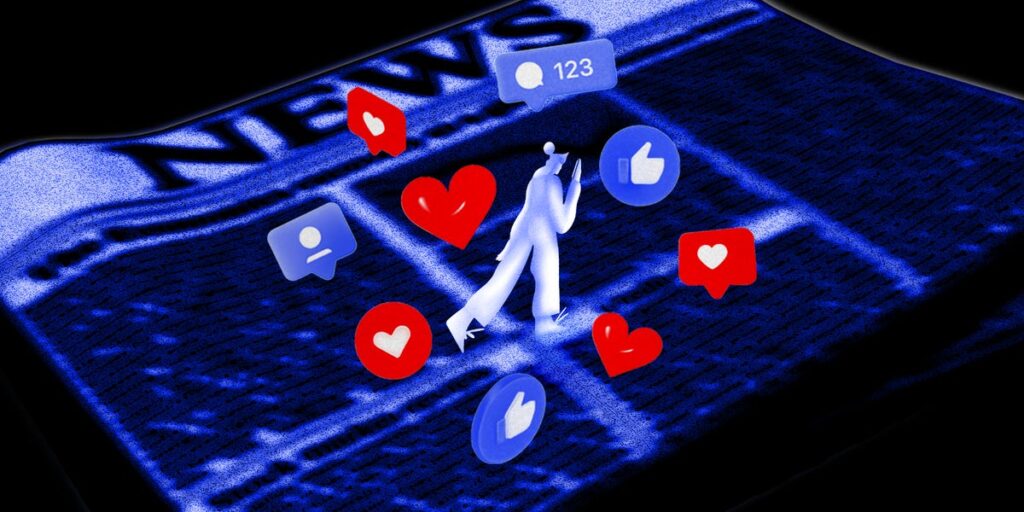Gen Z has come of age swimming in a gloppy stew of digital content. Every day they navigate memes, photos, social media, chats with their friends, flashes of video, influencers influencing, news articles from a zillion places across the net. How do America’s teens and youngest adults sort through all that digitized gunk to determine what’s important, or useful, or true?
A lot of folks would love to know. Social networks want young users. Media outlets want subscribers. Politicians want votes. Professors want to know why their students won’t read books. Everyone, it seems, has a stake in understanding Kids These Days.
Over the past couple of years, researchers at Jigsaw, a Google subsidiary that focuses on online politics and polarization, have been studying how Gen Zers digest and metabolize what they see online. The researchers were hoping that their work would provide one of the first in-depth, ethnographic studies of Gen Z’s “information literacy.” But the minute they started, their most fundamental assumption about the nature of digital information came crashing down.
“Within a week of actual research, we just threw out the term information literacy,” says Yasmin Green, Jigsaw’s CEO. Gen Zers, it turns out, are “not on a linear journey to evaluate the veracity of anything.” Instead, they’re engaged in what the researchers call “information sensibility” — a “socially informed” practice that relies on “folk heuristics of credibility.” In other words, Gen Zers know the difference between rock-solid news and AI-generated memes. They just don’t care.
Jigsaw’s findings offer a revealing glimpse into the digital mindset of Gen Z. Where older generations are out there struggling to fact-check information and cite sources, Gen Zers don’t even bother. They just read the headlines and then speed-scroll to the comments, to see what everyone else says. They’re outsourcing the determination of truth and importance to like-minded, trusted influencers. And if an article’s too long, they just skip it. They don’t want to see stuff that might force them to think too hard, or that upsets them emotionally. If they have a goal, Jigsaw found, it’s to learn what they need to know to remain cool and conversant in their chosen social groups.
“The old guard is like: ‘Yeah, but you have to care ultimately about the truth,'” Green says. “The Gen Z take is: ‘You can tell me your truth and what you think is important.'” What establishes the relevance of a claim isn’t some established notion of authority. It’s the social signals they get from their peers.
Jigsaw’s research doesn’t purport to be statistically significant. They didn’t poll a large group of Gen Z users about their digital habits. Instead, they relied on intense interviews with a handful of 13- to 24-year-olds from a representative range of demographics, classes, and genders. They were doing what anthropologists do in the field — looking for qualitative depth rather than quantitative data.
What they heard surprised them. Young folks basically say they see no difference between going online for news versus for social interaction. Gen Zers approach most of their digital experience in what the researchers call “timepass” mode, just looking to not be bored. If they want to answer a question or learn something new, they might turn to a search engine, but they’re acquiring new information mainly via their social feeds, which are algorithmically pruned to reflect what they care about and who they trust. In short, they’ve created their own filters to process an onslaught of digitized information. Only the important stuff shows up, and if something shows up, it must be important.
They don’t read long articles. And they don’t trust anything with ads, or paywalls, or pop-ups asking for donations or subscriptions. “If you’re making clickbait, you have zero faith in your content,” one subject told the researchers. “And news sources — even CNN and The New York Times — do clickbait. I throw those articles away immediately.”
For Gen Z, the online world resembles the stratified, cliquish lunchroom of a 1980s teen movie. Instead of listening to stuffy old teachers, like CNN and the Times, they take their cues from online influencers — the queen bees and quarterback bros at the top of the social hierarchy. The influencers’ personal experience makes them authentic, and they speak Gen Z’s language.
“Gen Zers will have a favorite influencer or set of influencers who they essentially outsource their trust to, and then they’re incredibly loyal to everything that influencer is saying,” says Beth Goldberg, Jigsaw’s head of research. “It becomes extremely costly to fall out of that influencer’s group, because they’re getting all their information from them.”
None of this means that Gen Z is any less intelligent or diligent than other generations. They know how to research something more deeply. It’s just that, usually, they don’t wanna. “They tap into those critical literacy skills in a really small proportion of the time they spend online,” Goldberg says. If they’re prepping for an argument they know they’re going to have, or when they have to make big life decisions about schools or investments, they’re willing to deal with the drudgery of factfinding. “But the vast majority of the time, they’re spending their time mindlessly in timepass mode. Veracity was not only not top of mind, it actually wasn’t important to them at all.”
When one subject shared a fake image of Donald Trump running from the NYPD, the researchers challenged them on it. “They kind of shrugged,” Goldberg says. From the subject’s perspective, they were using their critical thinking and media-literacy skills. After all, Trump was, at the time, headed for a criminal trial in New York. It could have been true.
And when it comes to things like diet or wellness, Gen Zers will just try it on their own bodies and see if it works. They perceive that as a safe way to do their own research, mostly because it’s not hurting anyone else. If that new diet or exercise regimen “works” on their body, that’s more believable than data showing its effects on a whole population.
If facty-sounding stuff does manage to sneak into Gen Z’s feeds — claims about what constitutes a healthy diet, or what Trump would do as president, or whether Ukraine or Russia is to blame for Russia’s invasion of Ukraine — they’re likely to head straight for the comments. That’s partly because they know the digital hoi polloi will quickly unmask any fake news. But it’s also because they’re concerned about whether the news — or a particular reaction to it — might prove to be a cancelable take.
“Cancel culture came to be a thing as they were growing up. They were trained and attend to how to perform, and not perform, to avoid that,” says Goldberg. “They’re getting trusted information from closed group chats or followers with private feeds, so they’re able to perform that they’re part of an in-group and can perform specific social signals.” For Gen Z, checking what other people are saying in the comments isn’t shallow. It’s a matter of social life or death.
If this sounds like a generation that will believe any flimflam they encounter and never subscribe to a newspaper, well, the researchers at Jigsaw worry about that too. But the good news is, Gen Zers aren’t seeing as much intentional falsehood as you might think. Research shows that most mis- and disinformation is being made and consumed by a dwindling minority of users who seek it out, not sprayed algorithmically into the eyeballs of credulous, internet-surfing teens. “Casual consumption of silly TikToks is very unlikely to lead someone into a dark corner of hate or misinformation,” says David Rothschild, an economist at Microsoft Research who studies online behavior. “It is highly likely that if they get there, they chose to get there.”
All of us are consuming less formal news content these days, like TV or newspapers. And like Gen Z, we’re all relying more and more on our social networks to tell us what’s going on. A recent study from the Pew Research Center found that most users on Facebook, Instagram, X, and TikTok encounter news frequently. On X, it most often comes from the media outlets and journalists who actually produced the news. On Facebook and Instagram, it comes via family and friends whose viewpoints, for better or worse, you already know. But on TikTok — with its disproportionately younger user base — the source is usually influencers. They aggregate, meta-analyze, and pre-digest what other sources are saying. Maybe that’s why users on TikTok, compared with other platforms, say they’re unlikely to be “worn out” by the news they see. Someone else already did the hard work; they’re getting the executive summary.
As clickbait-avoidant Gen Zers might suspect, Jigsaw’s interest in their online behavior isn’t purely academic. The Google subsidiary makes software called Perspective that lots of news outlets — including The New York Times — use to moderate their comment sections. The new iteration of Perspective incorporates Jigsaw’s latest findings, elevating comments that contain warm and fuzzy “bridging” sentiments, like curiosity and reasonableness, to the top of the section. The aim is to reach Gen Z readers where they live — scrolling through the comments — and turn them into subscribers. By studying Gen Z in the wild, Jigsaw can lay better traps for them in their native habitat.
As a Gen Xer, I’m inherently skeptical of broad pronouncements about the up-and-coming generation. You should have heard some of the stuff boomers said about us. (Not that we cared. Like, whatever.) But I’ll confess that I worried about the idea that Gen Z checks the comments to decide what to believe. So, after a therapeutic clutch at my pearls, I figured I’d better check it out. To evaluate Jigsaw’s research, I performed a scientific gut check: I looked at Google Scholar to see how many other researchers had cited the study. That’s a standard metric for how much a field values any given journal article.
And then I realized: I was basically checking the comments. We all do it — we look for lots of links, for 5-star reviews, for what the replies say. These are all valid ways to surf the modern social-informational ecosystem. The kids are all right, and all right.
Still, I wondered what Gen Zers themselves might make of Jigsaw’s research. Conveniently, two of them live in my house and call me Dad. So I texted them the findings, along with a question-mark emoji.
“Yeah, seems right,” the younger one replied. “But you know not all of us do that.”
I counted myself lucky — that was more of a response than Goldberg got. “We always share the final results with respondents,” she says. But when Goldberg asked her subjects what they thought of her research, true to her findings, all she heard back was the gravid silence of teenagers looking at their phones. “I’m not sure how many of our Gen Zers read our papers,” she concluded ruefully. No comment section, no comment.
Adam Rogers is a senior correspondent at Business Insider.
Read the full article here
















